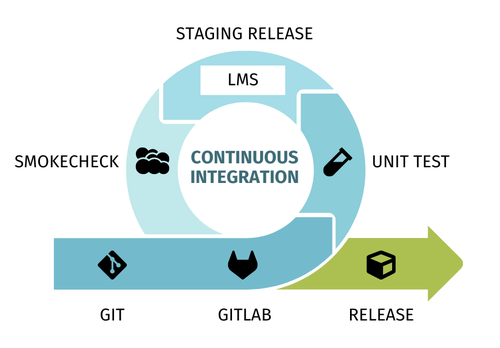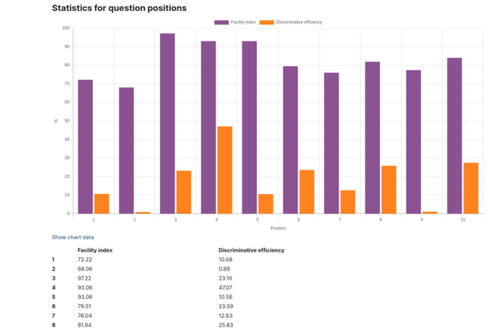Keeping on top of Learning Management System (LMS) platform trends ensures you've got all the tools you need for your LMS toolbelt. Being aware of enhancements, trends, and new tools means you can make informed decisions about what works best for you and your learners. For example, how to improve engagement, retention of information, and measure how your LMS content is performing. In this blog post, we’ll cover key LMS trends.
A brief overview of the LMS
One of the first known instances of EdTech (educational technology) was created 100 years ago by Sidney L. Pressey, called ‘the teaching machine’. It worked by only allowing you to move on to the next question when you answered correctly, so your learning was self-directed. In 2024, EdTech has come a long way due to vast technological advances including LMSs as a popular teaching method.
The adoption of LMS software has skyrocketed post-pandemic, with the estimated number of users in 2024 being 73.8 million and likely to continue to grow. This is also reflected in popular LMS platforms, like Moodle which has over 46 million courses worldwide supporting learners. The huge uptake of industries and organisations using LMS software reflects new ways of working across many sectors.
- Higher education: 98% of universities have moved their classes online since 2020, providing flexibility to their students and modernising ways of learning.
- Corporate settings: staff training has shifted to offer more online content due to the increase of hybrid and remote work.
Using an LMS means location, time, and delivery of learning and training materials are flexible. Plus, compared to traditional learning, corporate e-learning requires 40% to 60% less time to complete. Since LMSs are scalable, updating course content or uploading critical content is an easy task if you’re not working with outdated authoring tools.
With the increase in the use of LMS platforms, there’s also been a rise in the use of artificial intelligence (AI). ChatGPT has led the forefront of AI innovation, becoming the fastest-growing application in history with over 100 million active users. Organisations have quickly adapted to working with AI to improve their applications. LMSs, like Moodle, are also utilising AI and as it becomes a norm across many other LMSs too, it’s a good example of how quickly you need to learn and adapt. Knowing what new trends and insights impact your LMS and learners will bolster your learner success strategy.
So, we’ve pulled together a few notable LMS trends and insights to improve your LMS for 2024.
9 LMS trends you should focus on for 2024
1. Social learning and collaboration
Social features like social media, discussion forums, chat rooms, and messaging apps continue to rise in popularity. By adding a social element to learning you’re supporting learners to connect and support each other as they learn. Plus, the social element of learning means they have the potential to retain knowledge through sharing or teaching others.
2. Microlearning
Microlearning is a way to deliver bite-sized training that is short and concise. And, it’s a great way to shape content into something achievable and measurable. Larger content is broken into more manageable pieces making it more memorable as it isn’t lost in a three-hour course. If you don't have the in-house expertise, consider partnering with an experienced eLearning consultant who is skilled in crafting microlearning content.
3. Content curation
Content curation is the act of filtering content and presenting it in an organised manner. It’s a great way to support your learners and provide relevant information in one place. The use of ePortfolios are a powerful pedagogical tool and can greatly assist learners with reflective learning.
You can integrate Mahara with Moodle and Tōtara to allow students to curate content such as TED talks, resources, topics, and blog posts.
You can learn more about the power of ePortfolios in our recent blog post.
4. Gamification
Gamifying LMS content can boost learner engagement with game-like elements to learning material. Elements can include advancing levels, earning badges, or prizes. Plus, gamified content can increase problem-solving skills and work alongside goal setting.
5. Video-based learning
Videos are excellent for introductions to topics, demonstrating how-to’s, and as an alternative to instruction manuals and guidebooks. Plus, you can repurpose longer videos into other bite-sized eLearning content. Video content can include:
- Quizzes.
- Interactive videos.
- Tests.
- Video coaches.
- Virtual classrooms.
6. Cloud-based LMS solutions
Next, consider using cloud services for hosting your LMS software. Essentially, cloud provides scalability, reliability, object storage, and even backups to help manage costs.
If you don’t have the in-house expertise to support migrating to the cloud, work with an experienced LMS partner to ensure a seamless experience. At Catalyst, we can help you with hosting, sovereign hosting and support you with CIaaS (Continuous Integration as a Service) for LMS platforms Moodle and Tōtara.

Essentially, CIaaS is a full-service wrapper that looks after:
- Upgrades.
- Updates.
- Maintaining back ups.
- Customisations.
- Plugins.
- Integrations.
- Keeping your LMS software running smoothly.
7. Learning analytics
LMS platforms like Moodle and Tōtara have reporting capabilities so you can understand how your content and learners are performing. Your LMS will likely have built-in analytics so you can run reports for courses and quizzes. To learn more about how analytics can support you to make data-driven decisions, check out our blog.

8. AI (artificial intelligence)
AI (artificial intelligence) can add a lot of value to your LMS and your learners as it brings in a new era of education. Moodle LMS has built-in AI features with a human-centered and research-based approach behind them. Other LMSs are adding AI functionality to their LMS software through plugins, including chatbots and task automation. So you can focus on creativity, innovation, and your learners use AI as a supporting tool to handle automated tasks.
9. Blogs
Encouraging your learners to reflect on their work and goals is a growing trend in learning and development. Reflective learning enables your learners to return to learning content with a critical eye and can help them plan for the future. Your learners can write blogs as part of their reflection and share their insights to support others.
Bonus tips
Below are two bonus tips to ensure your LMS remains fit for purpose.
- Staying on top of SCORM rot: SCORM can become uneditable after five years, so you need to be aware of the age of your content. Plus, there are more modern authoring tools other than SCORM available, such as H5P. Check out how to fix SCORM rot in our blog.
- Transforming the learner experience: to improve current content and create new content, begin by getting feedback from your learners. Then, it's a good idea to complete a full instructional design. The process covers the analysis of current content through to the development and deployment of new material as needed.
Outsource where in-housing is tight
It’s important to be up-to-date with what’s happening in the EdTech space, so you can be aware of trends and incorporate them into your LMS content. But if you don’t have the resources or in-house expertise, working with an experienced LMS partner with a full-service wrapper is a good solution.
Our eLearning experts at Catalyst are experienced in both corporate and educational settings. Whether it’s content development, a full instructional design, or a full-service wrapper to support your Moodle or Tōtara LMS, we can help. Contact our team today.